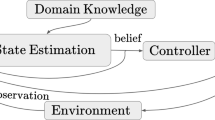Abstract
Robot localisation is predominantly resolved via parametric or non-parametric probabilistic methods. The particle filter, the most common non-parametric approach, is a Monte Carlo Localisation (MCL) method that is extensively used in robot localisation, as it can represent arbitrary probabilistic distributions, in contrast to Kalman filters, which is the standard parametric representation. In particle filters, a weight is internally assigned to each particle, and this weight serves as an indicator of a particle’s estimation certainty. Their output, the tracked object’s pose estimate, is implicitly assumed to be the weighted average pose of all particles; however, we argue that disregarding low-weight particles from this averaging process may yield an increase in accuracy. Furthermore, we argue that scan-matching, treated as a prosthesis of (or, put differently, fit in tandem with) a particle filter, can also lead to better accuracy. Moreover, we study the effect of feeding back this improved estimate to MCL, and introduce a feedback method that outperforms current state-of-the-art feedback approaches in accuracy and robustness, while alleviating their drawbacks. In the process of formulating these hypotheses we construct a localisation pipeline that admits configurations that are a superset of state-of-the-art configurations of tandem combinations of particle filters with scan-matching. The above hypotheses are tested in two simulated environments and results support our argumentation.
Similar content being viewed by others
References
Thrun, S., Burgard, W., Fox, D.: Probabilistic robotics (intelligent robotics and autonomous agents). MIT Press, Cambridge (2005)
Dellaert, F., Fox, D., Burgard, W., Thrun, S.: Monte Carlo localization for mobile robots. In: Proceedings 1999 IEEE international conference on robotics and automation (Cat. No.99CH36288C), Detroit, MI, USA, vol. 2, pp 1322–1328 (1999), https://doi.org/10.1109/ROBOT.1999.772544
Maybeck, P.: Stochastic Models, Estimation and Control, vol. 1. Academic Press, New York (1979)
Gutmann, J., Konolige, K.: Incremental mapping of large cyclic environments. In: Proceedings 1999 IEEE international symposium on computational intelligence in robotics and automation. CIRA’99 (Cat. No.99EX375), Monterey, CA, USA, pp 318–325 (1999), https://doi.org/10.1109/CIRA.1999.810068
Hahnel, D., Burgard, W., Fox, D., Thrun, S.: An efficient fastSLAM algorithm for generating maps of large-scale cyclic environments from raw laser range measurements. In: Proceedings 2003 IEEE/RSJ international conference on intelligent robots and systems (IROS 2003) (Cat. No.03CH37453), Las Vegas, NV, USA, vol. 1, pp 206–211 (2003), https://doi.org/10.1109/IROS.2003.1250629
Wang, C.-C., Thorpe, C., Thrun, S.: Online simultaneous localization and mapping with detection and tracking of moving objects: theory and results from a ground vehicle in crowded urban areas. In: 2003 IEEE international conference on robotics and automation (Cat. no.03CH37422), Taipei, Taiwan, vol. 1, pp 842–849 (2003), https://doi.org/10.1109/ROBOT.2003.1241698
Lacroix, S., Mallet, A., Bonnafous, D., Bauzil, G., Fleury, S., Herrb, M., Chatila, R.: Autonomous rover navigation on unknown terrains: functions and integration. Int. J. Robot. Res. 21(10–11), 917–942 (2002). https://doi.org/10.1177/0278364902021010841https://doi.org/10.1177/0278364902021010841
Minguez, J., Montesano, L., Anc Montano, L.: An architecture for sensor-based navigation in realistic dynamic and troublesome scenarios. In: 2004 IEEE/RSJ international conference on intelligent robots and systems (IROS) (IEEE Cat. No.04CH37566), 3, vol. 3, pp 2750–2756 (2004)
Montesano, L., Minguez, J., Montano, L.: Modeling dynamic scenarios for local sensor-based motion planning. Auton. Robot. 25, 231–251 (2008)
Schulz, D., Burgard, W., Fox, D., Cremers, A.B.: Tracking multiple moving targets with a mobile robot using particle filters and statistical data association. In: Proceedings 2001 ICRA. IEEE international conference on robotics and automation (Cat. No.01CH37164), Seoul, South Korea, vol. 2, pp 1665–1670 (2001), https://doi.org/10.1109/ROBOT.2001.932850
Coltin, Brian, Manuela, M.V.: Multi-Observation sensor resetting localization with ambiguous landmarks. Autonomous robots 35. https://doi.org/10.1007/s10514-013-9347-y (2011)
Liemhetcharat, S., Coltin, B., Veloso, M.M.: Vision-based cognition of a humanoid robot in standard platform robot soccer (2010)
Vasiljevic, G., Miklic, D., Draganjac, I., Kovacic, Z., Lista, P.: High-accuracy vehicle localization for autonomous warehousing (2016)
Peng, G., Zheng, W., Lu, Z., et al.: An improved AMCL algorithm based on laser scanning match in a complex and unstructured environment. Complexity 2018, 11 (2018). Article ID 2327637, https://doi.org/10.1155/2018/2327637
Röwekämper, J., Sprunk, C., Tipaldi, G.D., Stachniss, C., Pfaff, P., Burgard, W.: On the position accuracy of mobile robot localization based on particle filters combined with scan matching. In: 2012 IEEE/RSJ international conference on intelligent robots and systems, Vilamoura, pp 3158–3164 (2012), https://doi.org/10.1109/IROS.2012.6385988
Fox, D.: Adapting the sample size in particle filters through KLD-sampling. Int J Robot Res 22 (12), 985–1003 (2003). https://doi.org/10.1177/0278364903022012001
Censi, A: An ICP variant using a point-to-line metric. In: 2008 IEEE international conference on robotics and automation, Pasadena, CA, pp 19–25 (2008), https://doi.org/10.1109/ROBOT.2008.4543181
Besl, P.J., McKay, N.D.: A method for registration of 3-D shapes. IEEE Transactions on Pattern Analysis and Machine Intelligence 14(2), 239–256 (1992). https://doi.org/10.1109/34.121791, ISSN 0162-8828
Grimson, W., Eric L.: Object recognition by computer: the role of geometric constraints. MIT Press, Cambridge (1990). ISBN 0-262-07130-4
Lu, F., Milios, E.: Robot pose estimation in unknown environments by matching 2D range scans. J Intell Robot Syst 18(3), 249–275 (1997). https://doi.org/10.1023/A:1007957421070, ISSN 1573-0409
Pfister, S.T., Kriechbaum, K.L., Roumeliotis, S.I., Burdick, J.W.: Weighted range sensor matching algorithms for mobile robot displacement estimation. In: Proceedings 2002 IEEE international conference on robotics and automation (Cat. No.02CH37292), Washington, DC, USA, vol. 2, pp 1667–1674 (2002), https://doi.org/10.1109/ROBOT.2002.1014782
Chetverikov, D., Svirko, D., Stepanov, D., Krsek, P.: The trimmed iterative closest point algorithm. In: Object recognition supported by user interaction for service robots, Quebec City, Quebec, Canada, vol. 3, pp 545–548 (2002), https://doi.org/10.1109/ICPR.2002.1047997
Rousseeuw, P.J.: Least median of squares regression. J Ame Stat Assoc 79, 871–880 (1984). Taylor & Francis, https://doi.org/10.1080/01621459.1984.10477105
Biber, P., Strasser, W.: The normal distributions transform: a new approach to laser scan matching. In: Proceedings 2003 IEEE/RSJ international conference on intelligent robots and systems (IROS 2003) (Cat. No.03CH37453), Las Vegas, NV, USA, vol. 3, pp 2743–2748 (2003), https://doi.org/10.1109/IROS.2003.1249285
Atkinson, K.: An introduction to numerical analysis, 2nd edn, ISBN: 978-0-471-62489-9 (1989)
Zezhong, X., Jilin, L., Zhiyu, X.: Scan matching based on CLS relationships. In: IEEE international conference on robotics, intelligent systems and signal processing, 2003. Proceedings. 2003, Changsha, Hunan, China, vol. 1, pp 99–104 (2003), https://doi.org/10.1109/RISSP.2003.1285556
Censi, A., Iocchi, L., Grisetti, G.: Scan matching in the hough domain. In: Proceedings of the 2005 IEEE international conference on robotics and automation, pp 2739–2744 (2005)
Montesano, L., Minguez, J., Montano, L: Probabilistic scan matching for motion estimation in unstructured environments. In: 2005 IEEE/RSJ international conference on intelligent robots and systems, Edmonton, Alta, pp 3499–3504 (2005), https://doi.org/10.1109/IROS.2005.1545182
Diosi, A., Kleeman, L.: Laser scan matching in polar coordinates with application to SLAM. In: 2005 IEEE/RSJ international conference on intelligent robots and systems, Edmonton, Alta, pp 3317–3322 (2005), https://doi.org/10.1109/IROS.2005.1545181
Minguez, J., Lamiraux, F., Montesano, L.: Metric-Based Scan matching algorithms for mobile robot displacement estimation. In: Proceedings of the 2005 IEEE international conference on robotics and automation, Barcelona, Spain, pp 3557–3563 (2005), https://doi.org/10.1109/ROBOT.2005.1570661
Olson, E.B.: Real-time correlative scan matching. In: 2009 IEEE international conference on robotics and automation, Kobe, pp 4387–4393 (2009), https://doi.org/10.1109/ROBOT.2009.5152375
Chen, F., Inderjit, C., Omri, R.: Perimeter-based polar scan matching (PB-PSM) for 2D laser Odometry. J Intell Robot Syst 80, 231–254 (2015). ISSN 1573-0409, https://doi.org/10.1007/s10846-014-0158-y
Konecny, J., Prauzek, M., Kromer, P., Musilek, P.: Novel point-to-point scan matching algorithm based on cross-correlation, Mobile Information Systems (2016)
Sandberg, D., Wolff, K., Wahde, M.: A robot localization method based on laser scan matching, Advances in Robotics, pp 171–178. Springer, Berlin (2009). isbn 978-3-642-03983-6
Zhu, J., Zheng, N., Yuan, Z.: An Improved technique for robot global localization in indoor environments. International Journal of Advanced Robotic Systems. https://doi.org/10.5772/10525 (2011)
Beinschob, P., Reinke, C.: Advances in 3D data acquisition, mapping and localization in modern large-scale warehouses. In: 2014 IEEE 10th international conference on intelligent computer communication and processing (ICCP), Cluj Napoca, pp 265–271 (2014), https://doi.org/10.1109/ICCP.2014.6937007
Cummins, M., Newman, P.: Probabilistic appearance based navigation and loop closing. In: Proceedings 2007 IEEE international conference on robotics and automation, Roma, pp 2042–2048 (2007), https://doi.org/10.1109/ROBOT.2007.363622
Cherubini, Andrea, Colafrancesco, M., Oriolo, G., Freda, L., Chaumette, F.: Comparing appearance-based controllers for Nonholonomic navigation from a visual memory. In: ICRA 2009 workshop on safe navigation in open and dynamic environments: application to autonomous vehicles, Kobe, Japan, Japan (2009)
Sprunk, C., Tipaldi, G.D., Cherubini, A., Burgard, W.: Lidar-based teach-and-repeat of mobile robot trajectories. In: 2013 IEEE/RSJ international conference on intelligent robots and systems, Tokyo, pp 3144–3149 (2013), https://doi.org/10.1109/IROS.2013.6696803
Smith, A.F.M., Gelfand, A.E.: Bayesian statistics without tears: a Sampling–Resampling perspective. Ame. Stat. 46(2), 84–88 (1992). https://doi.org/10.1080/00031305.1992.10475856
Zhu, Q., başar, T.: Robust and resilient control design for cyber-physical systems with an application to power systems. In: Proceedings of the IEEE conference on decision and control, pp 4066–4071 (2011), https://doi.org/10.1109/CDC.6161031
Tavana, M., Busch, T.E., Davis, E.L.: Fuzzy multiple criteria workflow robustness and resiliency modeling with petri Nets. IJKBO, 1, 72–90 (2011)
Tzitzis, A., Megalou, S., Siachalou, S., Yioultsis, T., Kehagias, A., Tsardoulias, E., Filotheou, A., Symeonidis, A., Petrou, L., Dimitriou, A.G.: Phase ReLock - localization of RFID tags by a moving robot, to appear in the european conference on antennas and propagation, Krakow, Poland (2019)
Megalou, S., Tzitzis, A., Siachalou, S., Yioultsis, T., Sahalos, J., Tsardoulias, E., Filotheou, A., Symeonidis, A., Petrou, L., Bletsas, A., Dimitriou, A.G.: Fingerprinting localization of RFID tags with real-time performance-assessment, using a moving robot, to Appear in the european conference on antennas and propagation, Krakow, Poland (2019)
Acknowledgments
This research has been co-financed by the European Union and Greek national funds through the Operational Program Competitiveness, Entrepreneurship and Innovation, under the call RESEARCH CREATE INNOVATE (project code:T1EDK-03032).
Author information
Authors and Affiliations
Corresponding author
Additional information
Publisher’s Note
Springer Nature remains neutral with regard to jurisdictional claims in published maps and institutional affiliations.
Appendix: A
Appendix: A
This section features magnified versions of the figures found in Sections 7.1 and 7.2 for the use of drawing clearer comparisons between results of different selection (Section A) and feedback (Section B) methods.
1.1 A Focused Results of Tests on Selection Methods
Figures 11 and 12 comprise the distributions of the mean 2-norm total pose error of open-loop MCL per selection method tested across N = 100 simulations, as seen in Figs. 6 and 7 respectively, focused here for clarity of comparison purposes.
The distribution of the mean 2-norm total pose error of open-loop-MCL (to the left of each indicated selection method) and of the compound system’s (to the right of each indicated selection method) across N = 100 simulations according to population selection method in environment CORRIDOR, focused for clarity of comparison
The distribution of the mean 2-norm total pose error of open-loop-MCL (to the left of each indicated selection method) and of the compound system’s (to the right of each indicated selection method) across N = 100 simulations according to population selection method in environment WAREHOUSE, focused for clarity of comparison
1.2 B Focused Results of Tests on Feedback Methods
Figures 13 and 14 comprise the distributions of the mean 2-norm total pose error of open-loop MCL per feedback method tested across N = 100 simulations, as seen in Figs. 8 and 9 respectively, focused here for clarity of comparison purposes.
The distribution of the mean 2-norm total pose error of MCL (to the left of each indicated feedback method) and of the compound system’s (to the right of each indicated feedback method) across N = 100 simulations according to feedback method in environment CORRIDOR, focused for clarity of comparison
The distribution of the mean 2-norm total pose error of MCL (to the left of each indicated feedback method) and of the compound system’s (to the right of each indicated feedback method) across N = 100 simulations according to feedback method in environment WAREHOUSE, focused for clarity of comparison
Rights and permissions
About this article
Cite this article
Filotheou, A., Tsardoulias, E., Dimitriou, A. et al. Pose Selection and Feedback Methods in Tandem Combinations of Particle Filters with Scan-Matching for 2D Mobile Robot Localisation. J Intell Robot Syst 100, 925–944 (2020). https://doi.org/10.1007/s10846-020-01253-6
Received:
Accepted:
Published:
Issue Date:
DOI: https://doi.org/10.1007/s10846-020-01253-6








